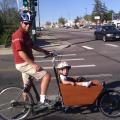When Deb Hubsmith founded the Safe Routes Partnership in 2005 – the same year that the first federal Safe Routes to School legislation was passed, authorizing funding to 50 states and the District of Columbia – her vision for the Safe Routes to School movement was much broader than the $612 million in initial funding outlined in the legislation. From the very beginning, Hubsmith believed that Safe Routes to School had the potential to transform our cities and towns into healthy, active communities where all people can walk, bicycle, and be physically active.
Resource Library
Joint Use Agreement 4: Joint Use of District and City Recreation Facilities is a model agreement in which the school district and local government agree to open all or designated recreational facilities to each other for community and school use. It also allows for third parties, such as youth organizations or youth sports leagues.
This resource reviews public policies that affect neighborhoods around schools and the ability of communities to preserve landmark schools for educational use.
 On September 17th, the U.S. House Transportation Committee will be voting on the transportation bill. One of the issues they’ll be debating is whether or not to continue the Transportation Alternatives Program (TAP), which is the main source of funding for Safe Routes to School, bicycling and walking.
On September 17th, the U.S. House Transportation Committee will be voting on the transportation bill. One of the issues they’ll be debating is whether or not to continue the Transportation Alternatives Program (TAP), which is the main source of funding for Safe Routes to School, bicycling and walking.
This fact sheet describes 6 key principles for euqity in transportation and health.
This report shows that physical activity among adults and high school students is higher in some states than others. Overall, most states have environmental and policy strategies in place that encourage physical activity.
As many of you know, it’s award season! From the Golden Globes to the Screen Actor's Guild Awards and all the way to the Oscars… there are nominees and winners. Here at the Safe Routes Partnership we wanted in on the award season action. For the past year, the National Shared Use Task Force has been engaging in conversations about ways that we could recognize all of the great work that is happening across the country in the shared use field.
This brief provides an overview of the burden of violence and state strategies to prevent and reduce violence within the context of the social determinants of health—where adolescents live, learn and play.
 Sara Zimmerman is program and policy director at the Safe Routes Partnership.
Sara Zimmerman is program and policy director at the Safe Routes Partnership.
Click here to see the Storify highlights from the #MoveEquity Tweetchat on ending street harassment to get more kids walking and biking.
The majority of Americans live in urban or suburban areas, though around 15 percent of Americans live in nonmetropolitan regions, which make up 72 percent of US land. Although the proportion of Americans who are rural residents has recently declined, these communities still comprise 46.1 million Americans (USDA, 2015). When it comes to health outcomes, researchers have identified inequities in rural areas, including higher rates of obesity compared with urban residents and differing levels of physical activity by geographic region (Yousefian et al., 2009; Hansen and Harley, 2015).
Back in May, we asked you to take action against the US Department of Transportation’s (USDOT) proposed “system performance measures” that would have measured the speed of cars and trucks in seven different ways, while devoting no measures at all to people walking, bicycling, and taking transit.
 In Atlanta, I’m sitting in a conference room with roughly 30 advocates from the public health sector who are here to talk about the work they are doing throughout the country in preventative health.
In Atlanta, I’m sitting in a conference room with roughly 30 advocates from the public health sector who are here to talk about the work they are doing throughout the country in preventative health.
 Since the release of the Senate transportation bill back in November, we have faced the specter of a transportation bill in which state departments of transportation would make the sole decisions about whether to dedicate any funding to Safe Routes to School, bicycling and walking.
Since the release of the Senate transportation bill back in November, we have faced the specter of a transportation bill in which state departments of transportation would make the sole decisions about whether to dedicate any funding to Safe Routes to School, bicycling and walking.
 On Wednesday, March 14, the full Senate passed MAP-21, a two-year transportation reauthorization bill (more details).
On Wednesday, March 14, the full Senate passed MAP-21, a two-year transportation reauthorization bill (more details).
 Whoever says rules are made to be broken is not aware of this interesting fact: Safe Routes to School-related laws have been effective in reducing injuries and increasing walking and bicycling to school.
Whoever says rules are made to be broken is not aware of this interesting fact: Safe Routes to School-related laws have been effective in reducing injuries and increasing walking and bicycling to school.
 May is National Bike Month, and May 9 marks the first ever official National Bike to School Day. Events celebrating bicycling and encouraging more ridership are taking place all throughout the country. The weather is warm, spring has sprung and
May is National Bike Month, and May 9 marks the first ever official National Bike to School Day. Events celebrating bicycling and encouraging more ridership are taking place all throughout the country. The weather is warm, spring has sprung and
 Jeanie Ward-Waller is a structural engineer who also holds two masters degrees. After working as a civil engineer on building construction for four years, Jeanie decided to do something big, bold and very different.
Jeanie Ward-Waller is a structural engineer who also holds two masters degrees. After working as a civil engineer on building construction for four years, Jeanie decided to do something big, bold and very different.
 Katie Couric said on CBS national news, ‘There is something so right about a kid on a bike’.
Katie Couric said on CBS national news, ‘There is something so right about a kid on a bike’.
 As I have reflected on yet another busy month with the Regional network project, I have thought about why the work the regional policy managers are doing is so unique, yet so pivotal, at this point in time.
As I have reflected on yet another busy month with the Regional network project, I have thought about why the work the regional policy managers are doing is so unique, yet so pivotal, at this point in time.

